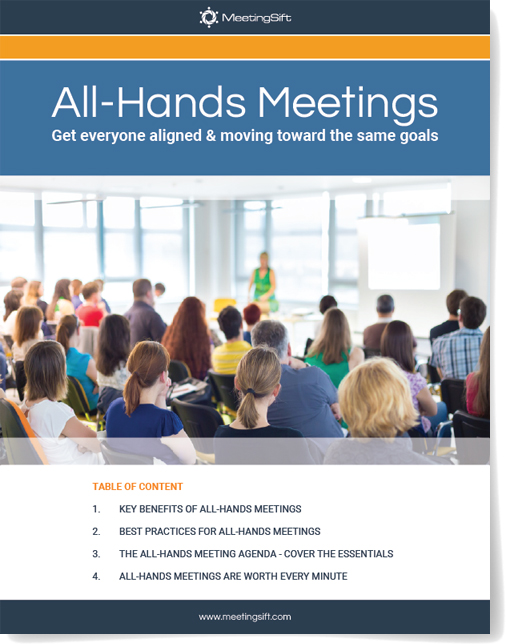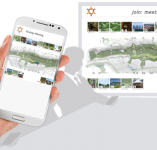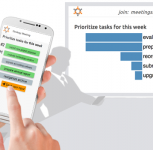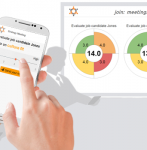The principles of Collective Intelligence (CI) can only be as good as the environment that allows them to thrive. Sharing, Openness, Peering, should be supported by the policies of an organization, and the means of communication chosen to encourage such participation.
This is where we really think that MeetingSift can benefit any size organization to make the most of their members specialized knowledge, skills, and creativity.
Shared Cognition
When an individual applies their cognitive abilities to create, problem solve, or critique they bring their unique skills and expertise to bear on that subject. The capture of this information is essential, with more differentiated and detailed input being all the more valuable to efforts in collective intelligence.
The MeetingSift system is particularly geared to the collection of individual input, and the aggregation of those small pieces into intelligible insight. The evaluation and prioritization activities are designed to help large numbers of people quickly weigh in on the topic at hand in quantifiable measures. The crafting of audience specific questions is an essential skill, but its value creation is immediate when we consider the opinions and critiques that can come out of expert minds. As this aggregate data comes together, MeetingSift helps by providing the necessary tools for emergence-level events to follow up seamlessly.
The Brainstorm and Discussion modules are specifically designed to allow large groups to contribute qualitative feedback into a process, opening up pathways for new ideas and emergent themes. Creative exercises like word-smithing, scenario building, persona crafting, verbal prototyping, and other qualitative methods can be inserted into a meeting at any point. As we’ve discussed briefly, it is most effective to brainstorm at the beginning of a new project or phase. Discussion is often best instigated after results from a previous activity, or multi-phase process, have already concluded; allowing you to ask what the results mean and indicate to the participants in the room.
Technology Supported Cooperation
Cooperation is as much a product of the environment and modes of communication within that space as it is a policy or goal. Creating such a cooperative space and ensuring open and equal lines of communication are difficult challenges, often requiring specialized skills in and of themselves.
MeetingSift is designed to address these problems by facilitating communication and democratizing the flow of information. While MeetingSift might not help you arrange chairs in a conference room, we have done our best to make such arrangements less important to the collective efforts of the engaged group.
Anonymity Increases Participation
MeetingSift defaults to an anonymous state of participants engagement, ensuring that identities and group politics do not play a role in the work and productivity of your meeting. We have found that participation can be severely limited, even in large group settings, for unspoken arrangements of social or political power that might be present. Anonymity allows people to freely give their input and opinion, without the fear of repercussions that could come from the voicing of unpopular ideas or critiques.
Real-time Visualizations of Group Input
Additionally, the real-time visualization of participant input, either quantitative or qualitative, allows people to quickly understand the major interests or points of contestation within a given project. In turning these results into a public facing artifact of the meeting, cooperative efforts can more quickly be brought to bear on achieving the goal of the meeting within the scope of group sentiment.
Group Coordination
Lastly, MeetingSift can help your organization coordinate the next steps moving forward by creating a forum in which collective action can be meted out, and accountability can be monitored. One method to achieve this is to use our system to nominate individuals or departments best suited to particular tasks. By using the brainstorm function as a nomination tool, and the polling activity as a selection process, your entire organization can participate in forming the agenda needed for project success.
Alternatively, a group might decide to use the prioritization module as a way to build a comprehensive workflow to focus collective efforts. Understanding how your organizations collective intellect gauges the work to be done, and the interdependencies of that work, can help the entirety of the group achieve better results in a more timely fashion. This more open format might very well lead to the formation of ad-hoc communities or workgroups – self-selected as best suited to the needs of the project phase.
How to Get Started
MeetingSift was designed to be able to integrate within any organization quickly and easily, by providing the most fundamental of meeting tools, and allowing them to be arranged as necessary to the accomplishment of goals. We wanted to make a software suite that could be easily picked up and used immediately by any meeting goer. That being said we feel there is much left to be explored and written about the use of MeetingSift from a projects inception point.
Starting with MeetingSift offers a number of efficiency enhancing features and advantages over meetings that are arranged in a more traditional way. Instead of starting with long presentations, and the “one-way street” of idea communication from the top down, why not start your next project as an exploration of your group’s collective intelligence. Before reviewing the market, or discussing the deign brief as presented by a client (which is still a necessity), why not open up the process to everyone from the beginning? It could help you ideate, problem solve, mitigate conflicts, and prioritize next steps from day one – allowing your whole team to get onboard with a new project and start contributing immediately.
If you’ve made it this far in our series on Collective Intelligence, and you aren’t already using MeetingSift at your organization, why don’t you give us a try. There’s no upfront cost, but high upfront value.
Tell ’em your collective intelligence made you do it.

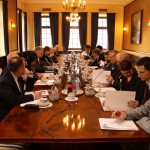 Five Great Methods for Group Decision Making
Five Great Methods for Group Decision Making 

